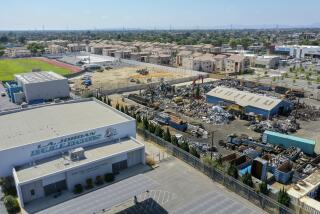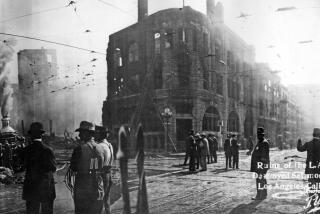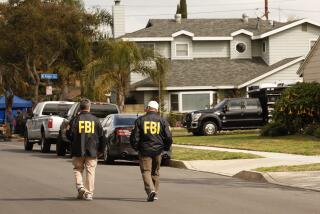Ex-Rocketdyne Worker Describes Fatal 1994 Blast
- Share via
A retired Rocketdyne mechanic testified Friday that he and four others were disposing of waste materials at the Santa Susana Field Laboratory near Chatsworth in 1994 when an explosion killed two veteran scientists.
Lee Wells, 70, of Newbury Park said he watched chemical engineer Otto K. Heiney pour a liquid into an aluminum box as he prepared to burn the chemical mixture at a secluded outdoor test site.
“I assumed we were burning waste,” Wells testified, comparing the process used on July 21 and 26, 1994, to that once used to legally dispose of leftover chemicals at the company’s old burn pit.
As Heiney poured the chemicals for what would have been the third burn of the day, the blast occurred, Wells said.
Wells is the first eyewitness to testify in the trial of two former Rocketdyne employees charged with federal environmental crimes. The trial is being held in U.S. District Court in Riverside.
“It was so loud I didn’t hear anything,” Wells testified. “I felt the blast and I looked down and my shirt was coming apart.”
When he realized what had occurred, Wells said, “I felt to see if I was all there . . . I knew I was burned but I didn’t know how bad.”
The July 26 blast killed Heiney, 53, of Canoga Park, and physicist Larry A. Pugh, 51, of Thousand Oaks. Wells suffered second- and third-degree burns to his face, arms and stomach.
On trial are Joseph E. Flanagan, 61, of Stanwood, Wash., and Edgar R. Wilson, 65, of Chatsworth, each charged with two felony counts of illegally disposing of chemical waste. Flanagan also is charged with one count of illegally storing the materials. Each count carries a maximum of five years in prison and a $250,000 fine.
As director of Rocketdyne’s Chemical Technology Group, Flanagan supervised the men involved in the burns, but was not present at the explosion. Wilson was a low-level technician in charge of igniting the burns.
The burns were conducted by Heiney, Pugh, Wilson, Wells and James F. Weber, the group’s hazardous waste coordinator.
Weber, 51, of Moorpark, also was charged with three felonies in the case, but pleaded guilty in August to one misdemeanor count. He is expected to testify later for the defense.
Rocketdyne’s then-parent company, Rockwell International Corp., also pleaded guilty in 1996 to three felony counts of mishandling hazardous chemicals in the same incident and paid a $6.5-million fine. The same year, Rocketdyne was sold to the Boeing Co..
Flanagan and Wilson deny the men were illegally disposing of waste on those two July days, as the government has alleged. Defense attorneys contend Heiney and Pugh were conducting legitimate scientific experiments when the blast occurred.
Wilson’s lawyer, Leonard Sharenow, said his client did not question his supervisors about the field work assigned to him.
Neither did Wells, who was granted prosecutorial immunity. Wells testified for the prosecution that, unlike in most scientific tests, neither Heiney nor any of the others had measured the amount of chemicals to be burned or took notes or photographs of the procedures used and results achieved.
“It seemed whatever [Heiney] came across, he put in” the box for burning, Wells testified. “Everything seemed random to me.”
When questioned by Assistant U.S. Atty. William Carter, Wells said he never saw a written procedure for the work.
Wells said he told Bert Moy, a former colleague, the fatal blast occurred during a “bucket test,” a phrase he used to refer to the illegal disposal of waste materials through burning.
Wells said he recognized the liquid Heiney was pouring before the blast as a propellent commonly used at the field laboratory, but did not know what other materials were burned during those two days.
More to Read
Sign up for Essential California
The most important California stories and recommendations in your inbox every morning.
You may occasionally receive promotional content from the Los Angeles Times.









